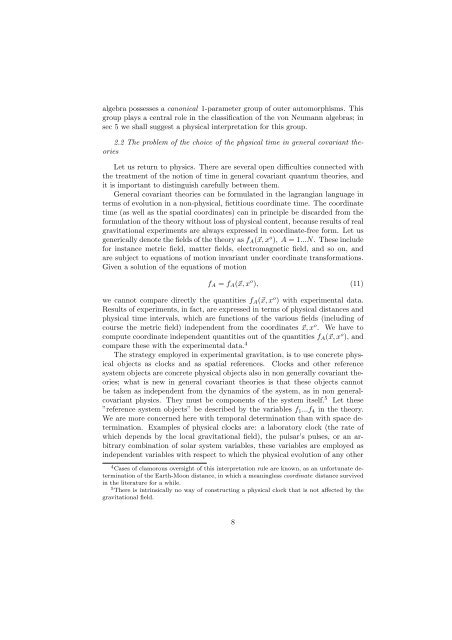Von Neumann algebra automorphisms and time ... - Alain Connes
Von Neumann algebra automorphisms and time ... - Alain Connes
Von Neumann algebra automorphisms and time ... - Alain Connes
You also want an ePaper? Increase the reach of your titles
YUMPU automatically turns print PDFs into web optimized ePapers that Google loves.
<strong>algebra</strong> possesses a canonical 1-parameter group of outer <strong>automorphisms</strong>. This<br />
group plays a central role in the classification of the von <strong>Neumann</strong> <strong>algebra</strong>s; in<br />
sec 5 we shall suggest a physical interpretation for this group.<br />
2.2 The problem of the choice of the physical <strong>time</strong> in general covariant theories<br />
Let us return to physics. There are several open difficulties connected with<br />
the treatment of the notion of <strong>time</strong> in general covariant quantum theories, <strong>and</strong><br />
it is important to distinguish carefully between them.<br />
General covariant theories can be formulated in the lagrangian language in<br />
terms of evolution in a non-physical, fictitious coordinate <strong>time</strong>. The coordinate<br />
<strong>time</strong> (as well as the spatial coordinates) can in principle be discarded from the<br />
formulation of the theory without loss of physical content, because results of real<br />
gravitational experiments are always expressed in coordinate-free form. Let us<br />
generically denote the fields of the theory as fA(�x, x o ), A = 1...N. These include<br />
for instance metric field, matter fields, electromagnetic field, <strong>and</strong> so on, <strong>and</strong><br />
are subject to equations of motion invariant under coordinate transformations.<br />
Given a solution of the equations of motion<br />
fA = fA(�x, x o ), (11)<br />
we cannot compare directly the quantities fA(�x, x o ) with experimental data.<br />
Results of experiments, in fact, are expressed in terms of physical distances <strong>and</strong><br />
physical <strong>time</strong> intervals, which are functions of the various fields (including of<br />
course the metric field) independent from the coordinates �x, x o . We have to<br />
compute coordinate independent quantities out of the quantities fA(�x, x o ), <strong>and</strong><br />
compare these with the experimental data. 4<br />
The strategy employed in experimental gravitation, is to use concrete physical<br />
objects as clocks <strong>and</strong> as spatial references. Clocks <strong>and</strong> other reference<br />
system objects are concrete physical objects also in non generally covariant theories;<br />
what is new in general covariant theories is that these objects cannot<br />
be taken as independent from the dynamics of the system, as in non generalcovariant<br />
physics. They must be components of the system itself. 5 Let these<br />
”reference system objects” be described by the variables f1...f4 in the theory.<br />
We are more concerned here with temporal determination than with space determination.<br />
Examples of physical clocks are: a laboratory clock (the rate of<br />
which depends by the local gravitational field), the pulsar’s pulses, or an arbitrary<br />
combination of solar system variables, these variables are employed as<br />
independent variables with respect to which the physical evolution of any other<br />
4 Cases of clamorous oversight of this interpretation rule are known, as an unfortunate determination<br />
of the Earth-Moon distance, in which a meaningless coordinate distance survived<br />
in the literature for a while.<br />
5 There is intrinsically no way of constructing a physical clock that is not affected by the<br />
gravitational field.<br />
8


